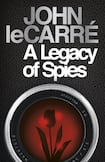
The American spymaster James Angleton had lunch every week with Kim Philby in Harvey’s restaurant on Pennsylvania Avenue, the cold war game played across a linen tablecloth with unimaginable subtlety. “What you have to understand about these matters,” Angleton said afterwards, “is that the past telescopes into the present.” John Le Carré’s last glance backwards at the bleak covert landscapes of the cold war sets out to test Angleton’s words.
Gulliam was master spy George Smileys colleague and confidante in the days of Tinker, Tailor, Soldier Spy. He's in retirement when the past comes looking for him. The children of Alec Leamus and Liz Gold, operatives gunned down by the Stasi during Operation Windfall are threatening to sue the service for malfeasance. The politicians are looking for cover, and in lieu of cover, a scapecoat.
The premise is thin. It falls under Ian Fleming’s description of his own plots as being possible but not probable. But that isn’t important. It’s the look back that matters, the cold war textures rising like east Berlin fog through the pages. We’re in the world of dead drops, micro-dots and minuature cameras. Agents are joes and everyone is expendable. The headquarters is the Circus, reeking of copy fluid and bad faith. The armchairs are overstuffed, the fire grates empty, the austerity and lovelessness of the minor public school become the setting for inky treachery. The phantoms of empire walk the corridors, scheming in tweeds.
Guilliam is ordered to London and installed in a coldwater flat in Dolphin square. There is a long interrogation scene conducted by a young operative inheritor of the service tradition of cheery heartlessness. The interrogation is a narrative device to deliver the rest of the story but there is a steeltrap architecture to it worthy of a Lubyanka basement and Gulliam’s story starts to unravel.
Flashbacks bring us to the postwar murk of Berlin. There’s a telltale click on the phone line. Hidden microphones tuned to the pillow talk of the careless. Operation Windfall is the only game in town, a high level mole feeds vital bloc information to the service. What price is to be paid to cement his position, and who is to be sacrificed? Guillam is up to his neck in it.
The tortured
Back in present-day London Guillam is forced to reveal the Windfall archive. He knows that joining the service is the fatal compromise and all following choices are between bad and worse. Your fate is always in other hands and can only be settled or deferred. Unforgiving young minds deliver judgement on what to them is history, and to Guilliam and his colleagues were vital decisions made in the moment, their lives and apparently, the fate of the west, in jeopardy.
Le Carré sets out his characters as moral grotesques while allowing them humanity. His utilitarian prose overlays real insight, and the insight is what shapes the work. Of the broken agent Jim Prideaux : “The tortured are a class apart. You can imagine – just – where they’ve been, but never what they’ve brought back.” An east German doctor turns to the west on hearing the screams of a claustrophobic woman nailed into a wooden box as part of a Stasi interrogation, the image delivered as an aside and all the more effective for it. Le Carré knows the power of words, and of silence. And he knows how to reach beyond the stereotype.
Le Carré has always seen the spy as a sin-eater at best, and George Smiley is is the great sin-eater, a psychic presence in the book from the first page. He is unknowable. Like Gulliam’s Uncle Markus, he is “born secret”. He sees the game many moves ahead, intuits the outcomes before they come to pass, envies others their inability to see into the future for it portends nothing good. But we are never to know if there is a profane relish to his tradecraft, or if he is tormented by the human cost.
Smiley’s wife Ann’s infidelity provides a counterweight of exquisite hurt to his artfulness. The heart has its own damaged tradecraft, and Le Carré draws on a nexus between sexual fidelity and high-level treachery. Le Carré’s women are the inscrutable and the preyed-upon, better often at the game than the men are, or at least more aware of what’s at stake for the unwary. Even in the worst years they could see the ghosts of the future, the children of the dead trailing their sorrows behind them, children the real legatees of the spy years.
The inside game
Angleton and Philby’s game was about the great mole, the insider. Was it one or the other, was it a chimera to throw confusion into the other side? Did both sides cancel each other out? Operation Windfall has the same structure and asks the same questions. Conspiracy being in Don DeLilo’s words, “the inside game, cold, sure undistracted, forever closed off from us”. The feeling that somewhere out there someone, however ammoral, is in charge, the spy’s yearning heart giving shape to that terrible hidden need.
In the closing scenes of A Legacy of Spies, Gulliam is told that the spies are not the cure, they're the disease, that they live in the dark because they fear the light. The speaker is Alec Leamus' son. Forgotten operations, forgotten sacrifices, forgotten victims haunt the pages. You suspect George Smiley's revelation that he has always felt himself European rather than British belongs to the author and to today's politics, but Le Carré has always had his heart in more or less the right place. He has earned the right to put words in the old spy's mouth.
Eoin McNamee’s novels include the Ultras and 12:23












